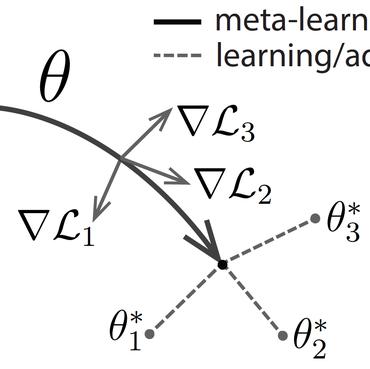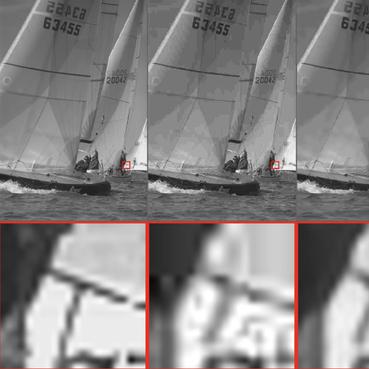Search Results for author: Ruud J. G. van Sloun
Found 29 papers, 16 papers with code
Residual Quantization with Implicit Neural Codebooks
1 code implementation • 26 Jan 2024 • Iris A. M. Huijben, Matthijs Douze, Matthew Muckley, Ruud J. G. van Sloun, Jakob Verbeek
For example, QINCo achieves better nearest-neighbor search accuracy using 12-byte codes than the state-of-the-art UNQ using 16 bytes on the BigANN1M and Deep1M datasets.
Investigating and Improving Latent Density Segmentation Models for Aleatoric Uncertainty Quantification in Medical Imaging
no code implementations • 31 Jul 2023 • M. M. Amaan Valiuddin, Christiaan G. A. Viviers, Ruud J. G. van Sloun, Peter H. N. de With, Fons van der Sommen
Data uncertainties, such as sensor noise, occlusions or limitations in the acquisition method can introduce irreducible ambiguities in images, which result in varying, yet plausible, semantic hypotheses.
Dehazing Ultrasound using Diffusion Models
no code implementations • 20 Jul 2023 • Tristan S. W. Stevens, Faik C. Meral, Jason Yu, Iason Z. Apostolakis, Jean-Luc Robert, Ruud J. G. van Sloun
Alternatively, denoising algorithms are typically unable to remove highly structured and correlated noise, such as haze.
A Deep Learning Approach Utilizing Covariance Matrix Analysis for the ISBI Edited MRS Reconstruction Challenge
1 code implementation • 5 Jun 2023 • Julian P. Merkofer, Dennis M. J. van de Sande, Sina Amirrajab, Gerhard S. Drenthen, Mitko Veta, Jacobus F. A. Jansen, Marcel Breeuwer, Ruud J. G. van Sloun
This work proposes a method to accelerate the acquisition of high-quality edited magnetic resonance spectroscopy (MRS) scans using machine learning models taking the sample covariance matrix as input.
SubspaceNet: Deep Learning-Aided Subspace Methods for DoA Estimation
1 code implementation • 4 Jun 2023 • Dor H. Shmuel, Julian P. Merkofer, Guy Revach, Ruud J. G. van Sloun, Nir Shlezinger
Direction of arrival (DoA) estimation is a fundamental task in array processing.
Latent-KalmanNet: Learned Kalman Filtering for Tracking from High-Dimensional Signals
1 code implementation • 16 Apr 2023 • Itay Buchnik, Damiano Steger, Guy Revach, Ruud J. G. van Sloun, Tirza Routtenberg, Nir Shlezinger
In this work, we study tracking from high-dimensional measurements under complex settings using a hybrid model-based/data-driven approach.
Removing Structured Noise with Diffusion Models
1 code implementation • 20 Jan 2023 • Tristan S. W. Stevens, Hans van Gorp, Faik C. Meral, Junseob Shin, Jason Yu, Jean-Luc Robert, Ruud J. G. van Sloun
Solving ill-posed inverse problems requires careful formulation of prior beliefs over the signals of interest and an accurate description of their manifestation into noisy measurements.
HKF: Hierarchical Kalman Filtering with Online Learned Evolution Priors for Adaptive ECG Denoising
1 code implementation • 23 Oct 2022 • Guy Revach, Timur Locher, Nir Shlezinger, Ruud J. G. van Sloun, Rik Vullings
This paper introduces HKF, a hierarchical and adaptive Kalman filter, which uses a proprietary state space model to effectively capture both intra- and inter-heartbeat dynamics for ECG signal denoising.
Efficient Out-of-Distribution Detection of Melanoma with Wavelet-based Normalizing Flows
1 code implementation • 9 Aug 2022 • M. M. Amaan Valiuddin, Christiaan G. A. Viviers, Ruud J. G. van Sloun, Peter H. N. de With, Fons van der Sommen
In this work, we aim at using these biases with domain-level knowledge of melanoma, to improve likelihood-based OOD detection of malignant images.
SOM-CPC: Unsupervised Contrastive Learning with Self-Organizing Maps for Structured Representations of High-Rate Time Series
1 code implementation • 31 May 2022 • Iris A. M. Huijben, Arthur A. Nijdam, Sebastiaan Overeem, Merel M. van Gilst, Ruud J. G. van Sloun
Continuous monitoring with an ever-increasing number of sensors has become ubiquitous across many application domains.
Ultrasound Signal Processing: From Models to Deep Learning
no code implementations • 9 Apr 2022 • Ben Luijten, Nishith Chennakeshava, Yonina C. Eldar, Massimo Mischi, Ruud J. G. van Sloun
We aim to inspire the reader to further research in this area, and to address the opportunities within the field of ultrasound signal processing.
Deep Task-Based Analog-to-Digital Conversion
1 code implementation • 29 Jan 2022 • Nir Shlezinger, Ariel Amar, Ben Luijten, Ruud J. G. van Sloun, Yonina C. Eldar
In this work we design task-oriented ADCs which learn from data how to map an analog signal into a digital representation such that the system task can be efficiently carried out.
Accelerated Intravascular Ultrasound Imaging using Deep Reinforcement Learning
no code implementations • 24 Jan 2022 • Tristan S. W. Stevens, Nishith Chennakeshava, Frederik J. de Bruijn, Martin Pekař, Ruud J. G. van Sloun
Intravascular ultrasound (IVUS) offers a unique perspective in the treatment of vascular diseases by creating a sequence of ultrasound-slices acquired from within the vessel.
Ultrasound Speckle Suppression and Denoising using MRI-derived Normalizing Flow Priors
no code implementations • 24 Dec 2021 • Vincent van de Schaft, Ruud J. G. van Sloun
We here propose a new unsupervised ultrasound speckle reduction and image denoising method based on maximum-a-posteriori estimation with deep generative priors that are learned from high-quality MRI images.
Deep Proximal Learning for High-Resolution Plane Wave Compounding
no code implementations • 23 Dec 2021 • Nishith Chennakeshava, Ben Luijten, Massimo Mischi, Yonina C. Eldar, Ruud J. G. van Sloun
Plane Wave imaging enables many applications that require high frame rates, including localisation microscopy, shear wave elastography, and ultra-sensitive Doppler.
Unsupervised Learned Kalman Filtering
1 code implementation • 18 Oct 2021 • Guy Revach, Nir Shlezinger, Timur Locher, Xiaoyong Ni, Ruud J. G. van Sloun, Yonina C. Eldar
In this paper we adapt KalmanNet, which is a recently pro-posed deep neural network (DNN)-aided system whose architecture follows the operation of the model-based Kalman filter (KF), to learn its mapping in an unsupervised manner, i. e., without requiring ground-truth states.
RTSNet: Learning to Smooth in Partially Known State-Space Models (Preprint)
2 code implementations • 10 Oct 2021 • Guy Revach, Xiaoyong Ni, Nir Shlezinger, Ruud J. G. van Sloun, Yonina C. Eldar
The smoothing task is core to many signal processing applications.
Uncertainty in Data-Driven Kalman Filtering for Partially Known State-Space Models
1 code implementation • 10 Oct 2021 • Itzik Klein, Guy Revach, Nir Shlezinger, Jonas E. Mehr, Ruud J. G. van Sloun, Yonina. C. Eldar
Providing a metric of uncertainty alongside a state estimate is often crucial when tracking a dynamical system.
A Review of the Gumbel-max Trick and its Extensions for Discrete Stochasticity in Machine Learning
1 code implementation • 4 Oct 2021 • Iris A. M. Huijben, Wouter Kool, Max B. Paulus, Ruud J. G. van Sloun
The Gumbel-max trick is a method to draw a sample from a categorical distribution, given by its unnormalized (log-)probabilities.
DA-MUSIC: Data-Driven DoA Estimation via Deep Augmented MUSIC Algorithm
2 code implementations • 22 Sep 2021 • Julian P. Merkofer, Guy Revach, Nir Shlezinger, Tirza Routtenberg, Ruud J. G. van Sloun
A popular multi-signal DoA estimation method is the multiple signal classification (MUSIC) algorithm, which enables high-performance super-resolution DoA recovery while being highly applicable in practice.
KalmanNet: Neural Network Aided Kalman Filtering for Partially Known Dynamics
2 code implementations • 21 Jul 2021 • Guy Revach, Nir Shlezinger, Xiaoyong Ni, Adria Lopez Escoriza, Ruud J. G. van Sloun, Yonina C. Eldar
State estimation of dynamical systems in real-time is a fundamental task in signal processing.
Automated Gain Control Through Deep Reinforcement Learning for Downstream Radar Object Detection
no code implementations • 8 Jul 2021 • Tristan S. W. Stevens, R. Firat Tigrek, Eric S. Tammam, Ruud J. G. van Sloun
Cognitive radars are systems that rely on learning through interactions of the radar with the surrounding environment.
Deep Unfolding with Normalizing Flow Priors for Inverse Problems
no code implementations • 6 Jul 2021 • Xinyi Wei, Hans van Gorp, Lizeth Gonzalez Carabarin, Daniel Freedman, Yonina C. Eldar, Ruud J. G. van Sloun
Many application domains, spanning from computational photography to medical imaging, require recovery of high-fidelity images from noisy, incomplete or partial/compressed measurements.
Dynamic Probabilistic Pruning: A general framework for hardware-constrained pruning at different granularities
no code implementations • 26 May 2021 • Lizeth Gonzalez-Carabarin, Iris A. M. Huijben, Bastiaan S. Veeling, Alexandre Schmid, Ruud J. G. van Sloun
Relevantly, the non-magnitude-based nature of DPP allows for joint optimization of pruning and weight quantization in order to even further compress the network, which we show as well.
Deep probabilistic subsampling for task-adaptive compressed sensing
1 code implementation • ICLR 2020 • Iris A. M. Huijben, Bastiaan S. Veeling, Ruud J. G. van Sloun
The field of deep learning is commonly concerned with optimizing predictive models using large pre-acquired datasets of densely sampled datapoints or signals.
Learning Sampling and Model-Based Signal Recovery for Compressed Sensing MRI
no code implementations • 22 Apr 2020 • Iris A. M. Huijben, Bastiaan S. Veeling, Ruud J. G. van Sloun
Compressed sensing (CS) MRI relies on adequate undersampling of the k-space to accelerate the acquisition without compromising image quality.
Learning Sub-Sampling and Signal Recovery with Applications in Ultrasound Imaging
no code implementations • 15 Aug 2019 • Iris A. M. Huijben, Bastiaan S. Veeling, Kees Janse, Massimo Mischi, Ruud J. G. van Sloun
Compressed sensing emerged as a popular framework for sparse signal reconstruction from a small set of compressed measurements.
Deep Unfolded Robust PCA with Application to Clutter Suppression in Ultrasound
no code implementations • 20 Nov 2018 • Oren Solomon, Regev Cohen, Yi Zhang, Yi Yang, He Qiong, Jianwen Luo, Ruud J. G. van Sloun, Yonina C. Eldar
We compare the performance of the suggested deep network on both simulations and in-vivo rat brain scans, with a commonly practiced deep-network architecture and the fast iterative shrinkage algorithm, and show that our architecture exhibits better image quality and contrast.
Super-resolution Ultrasound Localization Microscopy through Deep Learning
no code implementations • 20 Apr 2018 • Ruud J. G. van Sloun, Oren Solomon, Matthew Bruce, Zin Z. Khaing, Hessel Wijkstra, Yonina C. Eldar, Massimo Mischi
This method, which we term Deep Ultrasound Localization Microscopy (Deep-ULM), exploits modern deep learning strategies and employs a convolutional neural network to perform localization microscopy in dense scenarios.









